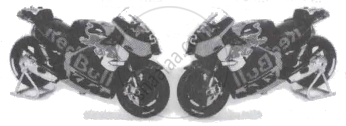Advertisements
Advertisements
प्रश्न
Find the distance between the lines:
`vecr = (hati + 2hatj - 4hatk) + λ(2hati + 3hatj + 6hatk)`;
`vecr = (3hati + 3hatj - 5hatk) + μ(4hati + 6hatj + 12hatk)`
उत्तर
Lines are parallel
`a_1/a_2 = b_1/b_2 = c_1/c_2`
`2/4 = 3/6 = 6/12`
`1/2 = 1/2 = 1/2`
`vecb = 2hati + 3hatj + 6hatk`
`|vecb| = sqrt(4 + 9 + 36)`
= `sqrt(49)`
= 7
S.D. = `|(vecb xx (veca_2 - veca_1))/|vecb||`
`veca_1 = hati + 2hatj - 4hatk`
`veca_2 = 3hati + 3hatj - 5hatk`
`veca_2 - veca_1 = 2hati + hatj - hatk`
`vecb xx (veca_2 - veca_1) = |(hati, hatj, hatk),(2, 3, 6),(2, 1, -1)|`
= `-9hati + 14hatj - 4hatk`
`|vecb xx (veca_2 - veca_1)| = sqrt(81 + 196 + 16)`
= `sqrt(293)`
S.D. = `sqrt(293)/7` units.
APPEARS IN
संबंधित प्रश्न
Find the shortest distance between the lines
`bar r = (4 hat i - hat j) + lambda(hat i + 2 hat j - 3 hat k)`
and
`bar r = (hat i - hat j + 2 hat k) + mu(hat i + 4 hat j -5 hat k)`
where λ and μ are parameters
Show that the following two lines are coplanar:
`(x−a+d)/(α−δ)= (y−a)/α=(z−a−d)/(α+δ) and (x−b+c)/(β−γ)=(y−b)/β=(z−b−c)/(β+γ)`
Show that lines:
`vecr=hati+hatj+hatk+lambda(hati-hat+hatk)`
`vecr=4hatj+2hatk+mu(2hati-hatj+3hatk)` are coplanar
Also, find the equation of the plane containing these lines.
Find the shortest distance between the lines:
`vecr = (hati+2hatj+hatk) + lambda(hati-hatj+hatk)` and `vecr = 2hati - hatj - hatk + mu(2hati + hatj + 2hatk)`
Find the shortest distance between the lines whose vector equations are `vecr = (hati + 2hatj + 3hatk) + lambda(hati - 3hatj + 2hatk)` and `vecr = 4hati + 5hatj + 6hatk + mu(2hati + 3hatj + hatk)`.
Find the shortest distance between lines `vecr = 6hati + 2hatj + 2hatk + lambda(hati - 2hatj + 2hatk)` and `vecr =-4hati - hatk + mu(3hati - 2hatj - 2hatk)`.
Find the shortest distance between the lines `(x+1)/7=(y+1)/(-6)=(z+1)/1 and (x-3)/1=(y-5)/(-2)=(z-7)/1`
Find the shortest distance between the lines
Find the shortest distance between the lines
|
The fuel cost per hour for running a train is proportional to the square of the speed it generates in km per hour. If the fuel costs ₹ 48 per hour at a speed of 16 km per hour and the fixed charges to run the train amount to ₹ 1200 per hour. Assume the speed of the train as v km/h. |
Given that the fuel cost per hour is k times the square of the speed the train generates in km/h, the value of k is:
|
The fuel cost per hour for running a train is proportional to the square of the speed it generates in km per hour. If the fuel costs ₹ 48 per hour at a speed of 16 km per hour and the fixed charges to run the train amount to ₹ 1200 per hour. Assume the speed of the train as v km/h. |
If the train has travelled a distance of 500 km, then the total cost of running the train is given by the function:
Find the shortest distance between the following lines:
`vecr = (hati + hatj - hatk) + s(2hati + hatj + hatk)`
`vecr = (hati + hatj - 2hatk) + t(4hati + 2hatj + 2hatk)`
Find the equation of line which passes through the point (1, 2, 3) and is parallel to the vector `3hati + 2hatj - 2hatk`
Find the angle between the following pair of lines:- `(x - 2)/ = (y - 1)/5 = (z + 3)/(-3)` and `(x + 2)/(-1) = (y - 4)/8 = (z - 5)/4`
Read the following passage and answer the questions given below.
|
Two motorcycles A and B are running at the speed more than the allowed speed on the roads represented by the lines `vecr = λ(hati + 2hatj - hatk)` and `vecr = (3hati + 3hatj) + μ(2hati + hatj + hatk)` respectively.
|
Based on the above information, answer the following questions:
- Find the shortest distance between the given lines.
- Find the point at which the motorcycles may collide.
Find the shortest distance between the following lines:
`vecr = 3hati + 5hatj + 7hatk + λ(hati - 2hatj + hatk)` and `vecr = (-hati - hatj - hatk) + μ(7hati - 6hatj + hatk)`.
If the shortest distance between the lines `vecr_1 = αhati + 2hatj + 2hatk + λ(hati - 2hatj + 2hatk)`, λ∈R, α > 0 `vecr_2 = - 4hati - hatk + μ(3hati - 2hatj - 2hatk)`, μ∈R is 9, then α is equal to ______.
If the shortest distance between the lines `(x - 1)/2 = (y - 2)/3 = (z - 3)/λ` and `(x - 2)/1 = (y - 4)/4 = (z - 5)/5` is `1/sqrt(3)`, then the sum of all possible values of λ is ______.
The shortest distance between the z-axis and the line x + y + 2z – 3 = 0 = 2x + 3y + 4z – 4, is ______.
The lines `vecr = hati + hatj - hatk + λ(2hati + 3hatj - 6hatk)` and `vecr = 2hati - hatj - hatk + μ(6hati + 9hatj - 18hatk)`; (where λ and μ are scalars) are ______.
Show that the line whose vector equation is `vecr = (2hati - 2hatj + 3hatk) + λ(hati - hatj + 4hatk)` is parallel to the plane whose vector equation is `vecr.(hati + 5hatj + hatk) = 5`. Also find the distance between them.


